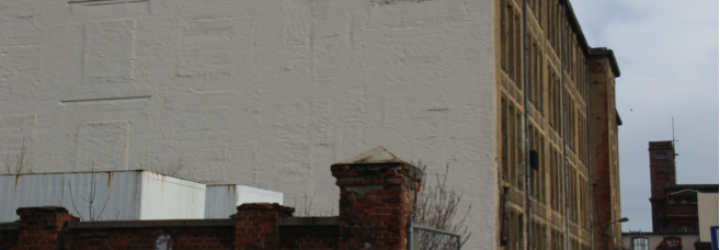In Leipzig’s west-end neighbourhood of Lindenau lies the Baumwollspinnerei, once the largest cotton spinning mill on the continent. Established in 1884, the Baumwollspinnerei remained in production throughout the 20th century before reinventing itself in the 1990s as a cultural complex that now houses galleries, studios, leisure and commercial space. While its international status may have faded since the departure of prominent New York and London galleries, the Baumwollspinnerei has been widely fêted as a successful example of adaptive reuse. The repurposing of 19th-century industrial buildings is an urban renewal strategy combining conservation and commercial interest that has been widely adopted internationally. But while each project may reflect larger forces that are reshaping urban landscapes around the globe – e.g. gentrification, de-industrialization, and consumer preferences in the experience economy – each project exists in local contexts that demand attention and analysis. The Baumwollspinnerei thus offers a case study for thinking about the relative successes of specific approaches to adaptive reuse, the significance of 21st-century nostalgia for abandoned industrial spaces, and how this nostalgia may function in the specific context of post-socialist Eastern Germany.
From Factory to Art Space: Where are the Lofts?
 The Baumwollspinnerei’s transformation from active mill to cultural complex began in the early 1990s as the mill’s administrators opened up the many vacant spaces to new uses. The new tenants, including artists Peter Bux, Peter Krauskopf, Rosa Loy, Volker Kriegel and Neo Rauch were drawn by the expansive studio spaces and low rents, setting up the first ateliers alongside spinners who were still working in the building. In 2001, the mill was sold to the newly founded Baumwollspinnerei Company Ltd. The new owners, who had just completed the renovation and sale of the nearby Stelzenhaus, saw potential in the existing tenancy structure and continued to develop the site as a home for contemporary fine art, a project that was considerably bolstered by the rising prominence of ‘The New Leipzig School’ in international art circles. While the Baumwollspinnerei now houses a variety of tenants – including shops, craftspeople, a dance studio, graphic designers, architectural and legal offices, a kindergarten and a call center – it is primarily known for its studios and galleries.
The Baumwollspinnerei’s transformation from active mill to cultural complex began in the early 1990s as the mill’s administrators opened up the many vacant spaces to new uses. The new tenants, including artists Peter Bux, Peter Krauskopf, Rosa Loy, Volker Kriegel and Neo Rauch were drawn by the expansive studio spaces and low rents, setting up the first ateliers alongside spinners who were still working in the building. In 2001, the mill was sold to the newly founded Baumwollspinnerei Company Ltd. The new owners, who had just completed the renovation and sale of the nearby Stelzenhaus, saw potential in the existing tenancy structure and continued to develop the site as a home for contemporary fine art, a project that was considerably bolstered by the rising prominence of ‘The New Leipzig School’ in international art circles. While the Baumwollspinnerei now houses a variety of tenants – including shops, craftspeople, a dance studio, graphic designers, architectural and legal offices, a kindergarten and a call center – it is primarily known for its studios and galleries. 
Artists were the cultural motors of the project from the outset; at a time when there was an abundance of affordable, vacant spaces in the city, it was the special requirements of scale and light that first drew artists to the old cotton mill. The high quality of the original structure was a further factor for the project’s success: renovations could be kept at a minimum, and the project could be financed with low rents.
The conversion of former factories to art spaces is a common practice across North America, Europe, and increasingly in Asia. Leipzig’s Baumwollspinnerei, however, offers an example of a commercial venture that has not turned into the residential gentrification of industrial buildings (aka ‘loft-ification’) described by Sharon Zukin and others. Much of this has to do with the original vision of the new owners, who have declared no interest in converting the space into residential lofts. But this is also a result of the continued availability of affordable space in many Leipzig neighbourhoods. While development continues in the vicinity, low demand means there is less incentive to convert spaces such as the Baumwollspinnerei into residential units. The difficult market conditions made initial financing hard to secure: it was only a regional savings bank, not an internationally active investor, which financed the plan. According to the Baumwollspinnerei’s developer and director, Bertram Schultze, this decision was facilitated by the fact that the local bank was familiar with the gallery owners and artists and uniquely able to understand the potential of the project. In such a market, the Baumwollspinnerei was not seen as a property for lucrative quick turnover, but a safe long-term investment, one that the developers also decided was worth keeping and renting over the longer term.
Borrowing from the Past, Building for the Future
The successful transformation of former industrial sites cannot be ensured through design quality alone, as evidenced by numerous projects around the globe that have failed to draw sufficient public interest and urban investment, despite the excellence of their design. When taking into account existing building stock and possibilities for reuse, successful projects must also consider the networks and specific traditions that already exist in the city in order to make abandoned spaces newly relevant in the local urban context.
While many banks balked at Bertram Schultze’s plan to create a centre for contemporary fine art in an abandoned East German cotton mill, he argues that despite tough market conditions, Leipzig – with its lengthy history of public appreciation and financial support for the arts – was in fact a fitting location for the project. With its centuries-long tradition as a centre for visual art, literature and music, there already existed a critical mass of interested residents eager to visit the galleries and events. Coinciding with the meteoric rise of the New Leipzig School, a group of young painters who had studied together at the Art Academy in Leipzig, the Baumwollspinnerei became an important venue that combined both the production and display of contemporary fine art, drawing not only locals, but international art dealers and tourists.
The Baumwollspinnerei’s growing status within the international art circuit, despite the odds of a depressed local economy, is a reminder that ‘creative’ city building cannot be achieved solely through the courting of large-scale events, corporate investment, or the construction of iconic architecture. Instead, successful projects tap into existing networks and communities to establish viable bridges between past and future. By concentrating a large number of galleries within one area, the Baumwollspinnerei established a locatable centre for Leipzig’s contemporary fine arts scene; the project – and the stars of the New Leipzig School that it housed – thus helped to renew a long-standing aspect of Leipzig’s urban identity, providing new impetus to the city’s reputation as a vibrant cultural centre.
Industrial Nostalgia
The topic of adaptive reuse is an opportunity to think not only about prospects for sustainability and urban renewal, but also about the elusive topic of nostalgia. The global enthusiasm for these projects is in large part fuelled by the affective response to the ambiance of abandoned industrial sites. There has been much critical attention paid to the significance of industrial nostalgia (sometimes pejoratively referred to as “smokestack nostalgia”) in the 21st century. On the one hand, many have rejected industrial nostalgia for what they regard as its tendency to uncritically sentimentalize the past and obscure the history of particular sites of work, including tensions of class, gender and race as well as the destructive effects of industry on human health and the environment. In a related response, criticism is leveled at the ways in which repurposed industrial sites are decontextualized to become a playground for middle- or upper-class consumption of goods and services, while the nostalgia for industrial ruin caters to a desire for urban adventure and disorder that is, in reality, sanitized and safe.
It is possible to see the Baumwollspinnerei in these terms. It is a commercial venture that houses some of Leipzig’s biggest art stars and prominent galleries, drawing art dealers and well-heeled tourists. It also capitalizes on the raw aesthetic of the building’s decay: crumbling walls, broken windows, debris and rusting machinery create an edgy atmosphere that lends alternative cachet to the work displayed there. And while the website offers a history of the building from its founding in 1884 to the present, visitors strolling through the grounds are unlikely to reflect on any specifics of the building’s past: e.g. the experience of workers under changing forms of government, the company’s participation in transnational networks of commerce and trade, or the individual and communal toll of unemployment as the mill was sold by the Treuhand, production slowed and eventually ceased entirely. The Baumwollspinnerei is not a musealized space: it does not resort to plaques or descriptive panels to narrate the story of the buildings. The site instead offers vague impressions, triggering fantasy and imagination. The past they offer is neither history, nor articulate memory, but a vague past without fixed meaning, a sense of unfulfilled past promises for the future.
What the site may evoke however, is a longing for the time of large-scale production of tangible goods, rather than invisible financial transactions, and the integration of material production in the fabric of the city. With its artists’ studios and artisanal workshops (as opposed to the chain stores, multiplexes or globally recognized products), the site perhaps evokes a bygone world in which products were locally made and not mass-produced, in conditions that could be easily viewed and assessed. Brownfields in Leipzig may in the first instance be a reminder of the collapse of an industrial economy after 1989, but its Gründerzeit origins link it to a time well before the wars, or the division and unification of Germany, linking it to other, capitalist versions of a Fordist model in Germany and elsewhere, reminding of how unification exacerbated a transition that began with deindustrialization in the West well before 1989.
But if the Baumwollspinnerei’s aura is fuelled by a nostalgia for a time of large scale production, with the worker at centre stage, it is then highly ironic that the site also houses a call centre, that 21st-century symbol of global capital, precarious work environments and the effacement of local identities. The co-existence of local artisans and information-age businesses make the Baumwollspinnerei both an escape from, but also a reminder of contemporary anxieties about globalization.




